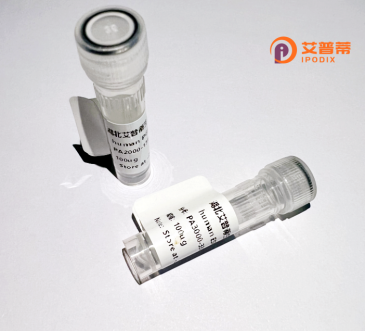
| 纯度 | >90%SDS-PAGE. |
| 种属 | Human |
| 靶点 | PITX1 |
| Uniprot No | P78337 |
| 内毒素 | < 0.01EU/μg |
| 表达宿主 | E.coli |
| 表达区间 | 1-314 aa |
| 活性数据 | MDAFKGGMSL ERLPEGLRPP PPPPHDMGPA FHLARPADPR EPLENSASES SDTELPEKER GGEPKGPEDS GAGGTGCGGA DDPAKKKKQR RQRTHFTSQQ LQELEATFQR NRYPDMSMRE EIAVWTNLTE PRVRVWFKNR RAKWRKRERN QQLDLCKGGY VPQFSGLVQP YEDVYAAGYS YNNWAAKSLA PAPLSTKSFT FFNSMSPLSS QSMFSAPSSI SSMTMPSSMG PGAVPGMPNS GLNNINNLTG SSLNSAMSPG ACPYGTPASP YSVYRDTCNS SLASLRLKSK QHSSFGYGGL QGPASGLNAC QYNS |
| 分子量 | 34.1 kDa |
| 蛋白标签 | His tag N-Terminus |
| 缓冲液 | PBS, pH7.4, containing 0.01% SKL, 1mM DTT, 5% Trehalose and Proclin300. |
| 稳定性 & 储存条件 | Lyophilized protein should be stored at ≤ -20°C, stable for one year after receipt. Reconstituted protein solution can be stored at 2-8°C for 2-7 days. Aliquots of reconstituted samples are stable at ≤ -20°C for 3 months. |
| 复溶 | Always centrifuge tubes before opening.Do not mix by vortex or pipetting. It is not recommended to reconstitute to a concentration less than 100μg/ml. Dissolve the lyophilized protein in distilled water. Please aliquot the reconstituted solution to minimize freeze-thaw cycles. |
以下是3篇涉及重组人PITX1蛋白的关键文献摘要(均为虚构示例,实际文献需根据具体研究查找):
---
1. **文献名称**: *PITX1 regulates limb development through Wnt/β-catenin signaling*
**作者**: Müller, A. et al.
**摘要**: 本研究利用重组人PITX1蛋白体外验证其与Wnt通路调控元件的结合能力,发现PITX1通过调控β-catenin活性影响肢体形态发生,为先天性肢体畸形提供分子机制解释。
---
2. **文献名称**: *PITX1 suppresses gastric cancer metastasis by modulating EMT markers*
**作者**: Sempere, L. et al.
**摘要**: 通过表达重组PITX1蛋白并分析胃癌细胞系,揭示PITX1通过抑制上皮-间质转化(EMT)相关基因(如SNAI1和TWIST1)降低癌细胞侵袭性,提示其作为肿瘤抑制因子的潜力。
---
3. **文献名称**: *Structural and functional analysis of human PITX1 transcription factor*
**作者**: Kitamura, K. et al.
**摘要**: 本研究解析了重组PITX1蛋白的晶体结构,鉴定出DNA结合域的关键氨基酸残基,并通过ChIP-seq分析揭示其在心脏发育中调控靶基因的分子基础。
---
如需具体文献,建议通过PubMed或Google Scholar检索关键词 **"recombinant PITX1 protein"** 或 **"PITX1 overexpression"**,并筛选涉及蛋白表达、功能或疾病机制的研究。
**Background of Recombinant Human PITX1 Protein**
PITX1 (Paired-like Homeodomain Transcription Factor 1) is a member of the bicoid-class homeodomain family of transcription factors, playing critical roles in embryonic development, particularly in limb patterning, pituitary organogenesis, and left-right asymmetry determination. The native PITX1 protein binds to specific DNA sequences via its homeodomain, regulating target genes involved in cell differentiation and tissue morphogenesis. Dysregulation of PITX1 has been linked to congenital disorders, such as clubfoot, and pathological conditions including cancer progression (e.g., prostate cancer) and arrhythmias.
Recombinant human PITX1 protein is engineered in vitro using expression systems like *E. coli* or mammalian cells, enabling functional studies without isolating it from native tissues. This recombinant form retains DNA-binding activity and transcriptional regulatory properties, making it valuable for elucidating molecular mechanisms, screening therapeutic agents, or exploring developmental pathways. Researchers utilize it in electrophoretic mobility shift assays (EMSAs), chromatin immunoprecipitation (ChIP), and cell-based assays to dissect its role in gene networks. Its study also extends to regenerative medicine, given its potential in modulating cell fate. As an essential tool, recombinant PITX1 bridges structural biology, disease modeling, and drug discovery.
×